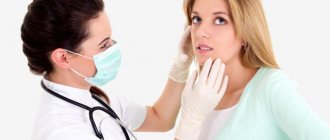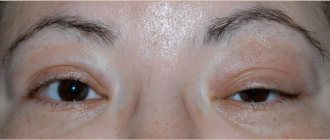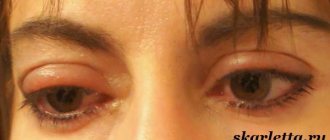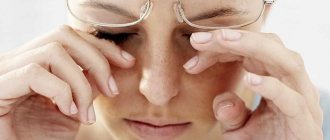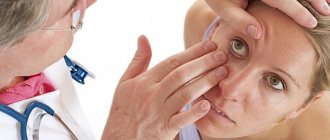What do bags under the eyes tell you?
One of the signs of local eye pathologies or systemic diseases is swelling of the upper or lower eyelids. It represents the excess content of intercellular fluid, lymph, blood or pus in the fiber.
Swelling of the eyelids is easy to detect during self-examination. Due to swelling, the eyes are difficult to open, which causes severe discomfort to the person. Swelling is often accompanied by pain, itching, burning and various discharges from the eyes.
Based on the frequency of occurrence of this symptom, isolated or recurrent symptoms are distinguished. Regarding location:
- Swelling of the upper eyelid. The patient notes swelling, a significant increase in the size of the eyelid, and its hanging over the eye.
- Swelling of the lower eyelid. Characterized by the formation of pronounced bags under the eyes. As a rule, swelling of the lower eyelid is bilateral.
What do bags under the eyes tell you? Swelling will not tell you anything good.
- They are usually the result of an incorrect daily routine: lack of sleep, alcohol abuse, poor diet.
- Swelling may be the result of allergies or problems with internal organs.
- Incorrectly selected cream, crying or premenstrual syndrome - all this can also lead to unfortunate swelling.
Regardless of the cause, swollen eyelids do not look aesthetically pleasing and add several years to your age. It is urgent to restore the attractiveness of the eyes. Decorative cosmetics cannot do this; it will only emphasize the puffiness. Other, more effective, emergency measures are needed.
Diagnostics
Based on the reasons described above, try to analyze your lifestyle, diet, and it may become clear why your eye is swollen.
Determining the true cause is only possible in a doctor’s office; he can prescribe:
- general blood and urine tests;
- examination of the heart, kidneys, liver and pelvis using ultrasound;
- in severe cases, CT and MRI.
If a chronic form of pathology is detected that provokes swelling under the eyes, it will not be possible to remove them forever and quickly. You will have to follow strict restrictions in the future to look good.
Causes of eye swelling
As they say, forewarned is forearmed. Therefore, you must not only be able to get rid of the problem, you also need to know why it arises. The reasons may be varied. Swelling of the eyelids develops as a result of the following factors:
- local inflammatory process of the upper eyelid – blepharitis;
- dacryocystitis – inflammation of the lacrimal gland and its ducts;
- mechanical damage to the mucous membrane;
- furunculosis;
- conjunctivitis;
- insomnia;
- alcohol abuse;
- smoking;
- use of low-quality cosmetics;
- insect bites;
- lymphatic drainage disorders;
- allergic reactions;
- age-related changes in the skin and tissue of the eyelid;
- formation of fatty hernias;
- use of medicines;
- excess salt intake;
- pregnancy.
In the presence of chronic diseases, water-salt metabolism is disrupted, so swollen eyelids are often a symptom of serious systemic pathologies:
- lesions of the cardiovascular system - arterial hypertension, coronary heart disease;
- hormonal disorders;
- chronic diseases of the genitourinary system - pyelonephritis, glomerulonephritis, renal failure, urolithiasis;
- diseases of the gastrointestinal tract - gastritis, ulcers;
- metabolic disorders due to diabetes mellitus.
It is important to remember: the cause of a cosmetic defect is hidden inside the body.
Swelling of the eyelids
Allergy
Diabetes
Pyelonephritis
11704 November 16
IMPORTANT!
The information in this section cannot be used for self-diagnosis and self-treatment.
In case of pain or other exacerbation of the disease, diagnostic tests should be prescribed only by the attending physician. To make a diagnosis and properly prescribe treatment, you should contact your doctor. Swelling of the eyelids: causes of occurrence, what diseases it occurs with, diagnosis and treatment methods.
Definition
Swelling of the eyelids is a pathological condition caused by the accumulation of fluid in the loose subcutaneous fatty tissue of the periorbital zone. It can be sporadic or rare, caused, for example, by insufficient sleep. Normally, swelling of the eyelids goes away on its own within 24 hours. If an unpleasant symptom takes on a permanent form, a full diagnosis of the body is required.
Swelling of the eyelids in most cases signals the development of serious pathological processes in the body.
Types of swelling of the eyelids
Swelling of the eyelids can be classified according to several parameters.
Firstly, edema can be of inflammatory (infectious, allergic) and non-inflammatory origin. In the first case, swelling of the eyelids is accompanied by redness, pain, increased temperature of the tissues of the periorbital zone, and lacrimation. The above signs are not typical for non-inflammatory edema.
Secondly, swelling of the eyelids can be unilateral or bilateral. Thus, unilateral edema is more often infectious, while bilateral edema has a wider range of causes.
Thirdly, edematous tissue can be soft and dense, which plays an important role in determining the cause of the development of edema.
Finally, swelling of the eyelids may be the only manifestation of edema syndrome, or may be combined with edema of other localizations, incl.
with swelling distributed throughout the body. Possible causes of eyelid swelling
Edema is the accumulation of excess fluid in tissues outside the blood and lymphatic vessels. There are several factors that contribute to the release and accumulation of fluid in the tissue. These include:
- high pressure created by the flow of blood inside the vessels;
- increasing the permeability of the vessel wall;
- a decrease in the concentration of blood plasma proteins, which, due to osmotic forces, retain the liquid part of the blood inside the blood vessel;
- an increase in the concentration of proteins and inorganic ions in tissues that attract water like a magnet.
The listed mechanisms play a dominant role in the development of eyelid swelling.
Among the more rare causes are a violation of the outflow of venous blood and a violation of the outflow of lymph due to narrowing of the lumen of blood vessels (for example, a blood clot, compression of a vessel from the outside, trauma). Symmetrical swelling of the eyelids that appears in the morning may be a consequence of consuming excessive amounts of liquid the night before bed.
Such swelling usually disappears on its own with proper drinking regimen. What diseases cause swelling of the eyelids?
First of all, swelling of the eyelids may indicate kidney disease:
- glomerulonephritis
- inflammatory damage to the glomeruli of the kidneys after a streptococcal or other infection; - secondary damage to the renal glomeruli in diabetes mellitus
,
chronic hypertension
; - pyelonephritis
is a disease (usually of infectious-inflammatory origin) characterized by damage to the renal collecting system and interstitium; - tubulointerstitial nephritis
- a group of diseases that primarily affect the kidney tubules, for example, toxic damage to the kidneys from salts of heavy metals; - other pathological processes in the kidneys, leading to the development of acute kidney injury
or
chronic kidney disease
.
Other pathologies that are characterized by the appearance of swelling of the eyelids include infectious diseases
of bacterial and viral origin.
Swelling of the eyelids is also a characteristic sign of allergic reactions, in particular angioedema
(Quincke's edema), manifested by swelling of the soft tissues of the head and neck: eyelids, mucous membranes in the pharynx and larynx.
This condition is life-threatening and occurs in response to the body’s contact with allergens coming from food, inhaled air, etc.
Dense persistent swelling of the eyelids is typical of
myxedema
- acquired insufficiency of the thyroid gland, which is characterized by a state of hypothyroidism - a decrease in the concentration of the hormones thyroxine and triiodothyronine.
Widespread swelling, incl. swelling of the eyelids, develops with severe heart failure
, however, “cardiac” edema is characterized by its spread from bottom to top: from the feet and legs to the upper half of the body.
Edema also develops when the synthesis of plasma proteins by the liver is impaired, which occurs, for example, in liver cirrhosis
.
Which doctors should I contact if swelling of the eyelids occurs?
Since there are many causes for the development of edema, the first doctor you should contact is a general practitioner or. After a comprehensive clinical, laboratory and instrumental examination, the patient can be referred to specialized specialists - a nephrologist (a doctor specializing in kidney diseases), an allergist-immunologist, an ophthalmologist, a hepatologist.
Diagnosis and examination of eyelid edema
The main goal of diagnosis is to establish the cause of eyelid edema. A thorough clinical examination gives the doctor a lot of information. However, kidney disease, one of the main causes of eyelid swelling, may have mild clinical manifestations. In this case, laboratory and instrumental diagnostics are required, which usually includes the following studies.
- clinical blood test with a detailed leukocyte formula to determine the presence of an inflammatory process in the body;
Massage treatments
Massage will help remove swelling. Using light movements, lightly pressing on the skin, massage the eyelids with your fingertips for several minutes. The skin in this area is very thin, delicate and requires careful handling.
To achieve the best effect, you must use natural oils: grape seed, almond, peach or moisturizer. After the massage procedure, you should briefly apply cotton pads soaked in cold water.
In addition, it is recommended to perform some exercises:
- Squeezing your eyes shut. You need to close your eyes tightly for 5-7 seconds, then open your eyes wide. The exercise should be repeated 10-12 times.
- Circular rotation of the eyeballs. It is necessary to perform several rotations clockwise, then counterclockwise. At the same time, you should keep your head straight.
- Blinking. You should blink quickly and relax your eye muscles for 10-12 seconds.
- Complete the set of exercises with palming.
Medications
Medicines should be used to eliminate swelling of the eyelids only as prescribed by the attending physician, after examination, tests and clarification of the diagnosis. Here are the main groups of drugs that are used to eliminate swelling:
- Antibiotics. Used for established bacterial infections. As a rule, antibacterial agents are prescribed for local use: Tetracycline ointment, Gentamicin or Erythromycin.
- Diuretics. Prescribed for decreased kidney function, sometimes for allergic edema. They use drugs in tablet form: Lasix, Furosemide.
- Antiviral drugs. Prescribed for established viral infections of the mucous membrane of the eyes: conjunctivitis, ophthalmic herpes. The most commonly used ointments are Virolex and Bonafton.
It is no secret that vasoconstrictor ointments aimed at eliminating bruises help relieve swelling from the eyes. They have anti-inflammatory, anti-edematous, thrombolytic abilities. They also contain cooling elements, which has a positive effect on severe swelling.
Thanks to the convenient formula and selected components, the effect of the product occurs in a couple of minutes. The result also lasts a long time – up to 12 hours. The anti-edema remedy must be purchased only at a pharmacy and used according to the instructions.
Creams and gel are not applied to the dermis. Some components may cause irritation; do not use the product on the mucous membrane, otherwise irritation will occur, tears will flow, and the appearance will be spoiled. If everything is done correctly, the cosmetic defect will quickly disappear.
Express methods for getting rid of edema
You cannot resort to express methods too often, because frequent swelling is an alarming signal, and they need to be treated with medication after diagnosis. Express methods help to quickly restore a fresh look to your eyes if you need to look good here and now.
Drugs
You should not take pharmaceutical medications too often, especially without a doctor’s advice. You should always take care to eliminate the root cause of the disease, and not just the symptoms.
In emergency cases, diuretics—drugs with a mild diuretic effect—help get rid of edema. Among them are Cyclomethiazide, Hypothiazide, Veroshpiron, Triamterene, Spironolactone.
Zodak and Cetrin help with allergic swelling and tearing.
Retinoic ointment, Curiosin gel, zinc ointment, Blepharogel, heparin ointment, Troxevasin gel, Tetracycline eye ointment are suitable for topical use.
Cosmetical tools
Cosmetic products that are used to eliminate facial swelling contain active natural ingredients that have a lifting effect.
REFERENCE! The most popular ingredients in cosmetics that help with swelling are hyaluronic acid, coffee, horse chestnut, and vitamin K.
The most popular skincare products are:
- Garnier caffeine gel;
- gel based on seaweed Stimul Eye Active;
- Blepharogel ointment with aloe vera extract and hyaluronic acid;
- KORA eye cream-gel with shea butter;
- lifting cream LiftActiv from Vichy.
The cost of these funds is quite high, so it is better to use them only in cases of extreme necessity. It will be much more effective to eliminate the main cause of swelling once and for all.
How to remove swelling from the eye after an impact: black glasses are canceled
First of all, after a blow, you must immediately apply cold: a few ice cubes, a cold spoon, a cup of cold water.
A compress of mashed potatoes, which should be wrapped in gauze or a clean cloth and applied to the sore spot for 5-10 minutes, then rinsed with water, helps relieve swelling.
An effective remedy for swelling is bodyagi gel. It is applied to the site of swelling in a thin layer. Leave for 10-15 minutes.
In the presence of a hematoma, the use of Troxevasin or Lyoton ointments gives excellent results.
Eye swelling due to allergies, what to do
In order to quickly relieve allergic swelling, it is necessary, first of all, to eliminate the effect of the factor that caused such a reaction (cosmetics, food, dust, animal hair, midge bite), and rinse the eyes with plenty of running water.
Then take an antiallergic drug or apply directly to the area of swelling. As a rule, antihistamines are used: Suprastin, Cetrin.
Cold compresses made from a piece of ice or frozen chamomile decoction have a good effect. You can also wipe the eyelid with a solution of novocaine or anesthesin. The area where the swelling has formed can be anointed with Prednisolone or Celestoderm.
Cosmetics to eliminate swelling
To effectively eliminate puffiness, it is recommended to use those cosmetics for the skin around the eyes that contain caffeine, which improves blood circulation in the tissues. Additional hydration can be achieved by adding vitamin E, essential oils, grape seed extracts, parsley, and rice bran to the product.
Cosmetic patches soaked in moisturizing and toning ingredients - aloe juice, glycerin - will help you get rid of swelling of the eyelids in a short time. Upon contact with the skin, all substances penetrate the skin, tighten it, improve lymph flow and blood circulation. Apply cosmetic patches every day at night or in the morning.
Prevention
Following simple recommendations will help minimize the risk of swelling. Avoid negative factors and your eyes will be healthy:
- Get at least eight hours of sleep. Adequate sleep is important for the health of the whole body;
- Consume carbonated drinks and coffee to a minimum;
- Try to eliminate salty foods from your diet;
- Avoid strong gusts of wind and pillars of dust;
- Minimize contact with the irritant, or better yet eliminate it altogether;
- Observe the rules of personal hygiene;
- Do not communicate with people suffering from ophthalmological diseases of infectious origin;
- Take care of your nervous system! Try to cry less and avoid stressful situations;
- Before going outside, apply a cream with a UV filter to the skin around the eyes;
- Do not abuse alcoholic beverages.
| If you have to work at a computer for a long time, take breaks every half hour. |
Traditional recipes against edema
To get your face in order in literally 15 minutes, you can use the following folk recipes:
Application of compresses
- Pour boiling water over the tea bag, put it in the refrigerator for 10 minutes to cool, then apply it to the eyelids.
- Grate raw potatoes, put the pulp on a piece of gauze, and apply to the eyes.
- Wrap a piece of ice in a bandage and wipe not only the area around the eye, but the entire face.
- A compress of chamomile infusion will remove swelling in just a couple of minutes. Brew pharmaceutical chamomile at the rate of 1-1.5 tbsp. l. half a glass of water, leave for 10-15 minutes. Then dip cotton pads into the infusion, squeeze lightly, and apply to eyes for 15 minutes.
- Prepare a decoction of parsley and celery. Grate the raw potatoes and add them to the hot broth. Leave for 15-20 minutes. Add a few drops of vegetable oil. Place the mixture on pieces of gauze. Make compresses 2-3 times a day.
- Cucumber. You can quickly remove swelling with the help of this healthy vegetable, which has the ability to draw excess moisture through the skin. The cucumber must be fresh and cold. You need to cut off two circles and put them on the eyes. Keep for 15-20 minutes.
- Cucumber juice quite effectively removes puffiness; you need to moisten cotton swabs with it and apply for 10 - 15 minutes.
Nourishing and skin-tightening masks
- Express mask made from cucumbers or cucumber juice. This is a proven, effective remedy. If time permits, you can grate the cucumber on a fine grater. Wrap the resulting composition in gauze and apply to the eyelids. You can simply cut the cucumber into rings and apply them for a quarter of an hour.
- A mask made from egg whites is effective: beat the whites with a mixer whisk; applied to swollen areas; After 15 minutes, when the product has dried, it is gently washed off with water. Protein also tightens the skin.
- Potato tuber slices save the eyes from swelling, bruising and discomfort; cabbage leaf in the form of a mask will help remove bruises.
- Pumpkin mask - boil pumpkin pieces until soft. After this, mash them with a spoon until a homogeneous paste forms, add 1 teaspoon of honey. Apply a warm, but not hot mask to the face and neck. After 15 minutes, remove everything and wash with warm water. The mask will help relieve swelling quickly and effectively for a long time.
Important: multiple traditional medicine recipes should be used in complex therapy or in cases where the source of swelling is lack of sleep or fatigue.
Treatment options
First of all, it is necessary to find the cause of the external defect. If this is a symptom of a disease that has been confirmed by a doctor, the initial stage of treatment will often remove the swelling completely. If no other signs of the disease bother you, you can resort to self-treatment.
General approach
Proper nutrition will help you in the fight for a healthy face. Increase the amount of fresh vegetables and fruits in your diet. Cleanse your body in the form of a diet: eat more fresh salads, drink fruit drinks and compotes. Remove canned food, processed foods and fast food from your weekly menu.
Make sure your day includes more time spent outdoors. In the bedroom, also open the window more often - if possible, throughout the night. Oxygen-enriched blood circulates better and does not stagnate.
Medications
Diuretics are used to remove excess fluid from the body, which becomes a source of edema.
It is important to remember that overuse of this method can lead to potassium deficiency. Gentle diuretics:
- Amiloride;
- Triamterene;
- Spironolactone.
Folk remedies
Based on the experience of generations, it is known that puffiness around the eyes is well relieved by:
- potatoes - slices are applied to the bags;
- cucumber - it is recommended to hold the vegetable cut into slices on the eyelid for 15-20 minutes;
- kefir - apply it to a cotton sponge and apply to the problem area.
Ice from a decoction of medicinal herbs: chamomile, sage, calendula works well to eliminate morning swelling.
Masks
The cosmetics industry offers a wide range of patches, gels, face masks
It is worth paying attention to the composition - it is desirable that it contains extracts or extracts of natural plants, as well as oils. If you choose a mask, pay attention to several nuances:
- Apply it only to clean, freshly washed skin;
- The time it takes to keep the mask on your face is on average 15-20 minutes;
- When distributing the cream or gel composition, do not rub it into the skin.
Compresses
An excellent remedy, familiar to our grandmothers, are compresses in the form of tea bags. The only thing that has changed since then is the quality of the tea. Make sure that the product does not contain harmful additives, essences or dyes. Otherwise, the treatment may have the opposite effect or irritate the eye mucosa.
Baths
Of course, no one will put their head in water, but it’s worth making foot baths that improve blood circulation. The recipe is simple - take cold water and add ice to it. Shock therapy tones even small capillaries and helps the vascular system increase activity. You should also not neglect chamomile and mint decoction.
Sea salt does an excellent job of toning. For better results, increase the amount of granules and walk on them with your feet. Stagnation will go away, and with it disruptions in the body’s functioning.
Massage
Light palpation stimulates blood supply to the eye area. Follow the steps by lubricating your hands with a mixture of olive and cosmetic oil:
- Touch the skin pointwise and tap it with your fingertips.
- Rub your palms together to make them warm. Apply to closed eyes. After 10 seconds, open them. You will feel the vigor of your facial muscles and visual acuity returning.
- Gently run your fingers over the skin. Move first from the nose to the temples, then in the opposite direction. This exercise also helps smooth out facial wrinkles.
How to prevent swelling
Naturally, you can get rid of this problem just by regularly leading a healthy lifestyle. If you are actively involved in sports, monitor the quality of your diet, do not indulge in alcohol, and do not allow stress to become the master of your life, then not only your eyes, but your entire body will thank you.
You will always look young and fresh, catching the admiring glances of others. If you follow these simple rules, a contrasting wash in the morning will be enough for you to look irresistible.



